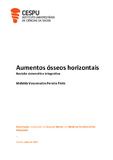Aumentos ósseos horizontais Revisão sistemática integrativa

Mostra/
Data
2023Autore
Pinto, Mafalda de Vasconcelos Pereira
Metadata
Mostra tutti i dati dell'itemAbstract
A reabsorção horizontal é um processo rápido e frequente, provocado por fatores patológicos como o edentulismo prolongado, que por vezes impossibilita a reabilitação oral com implantes dentários. Enxerto ósseo em bloco, regeneração óssea guiada (ROG) e split crest (SC), associados a materiais de enxerto, permitem o aumento ósseo horizontal do rebordo alveolar. O objetivo deste trabalho é determinar a melhor técnica para realização de aumento ósseo alveolar horizontal de pacientes com rebordo alveolar atrófico. Foi realizada uma pesquisa bibliográfica nas bases de dados PubMed, ScienceDirect e LILACS, com as seguintes palavras-chave: “alveolar ridge augmentation”; “bone resorption”; “bone substitutes”; “bone transplantation”; “bone regeneration”; “dental implants”. Foram selecionados 14 artigos, publicados em língua inglesa, nos últimos 10 anos. Ganhos ósseos suficientes para a reabilitação com implantes dentários foram verificados em todas as técnicas, independentemente do material de enxerto, porém não há significado estatístico nos resultados. Apesar da reabsorção óssea ser inerente a todos os procedimentos, o enxerto autógeno em bloco (AOB) é uma técnica invasiva e está mais associada a complicações no pós-operatório, como distúrbios sensoriais e hematomas. ROG com malha de titânio é procedimento sensível, com maior incidência de deiscência. SC requer menor tempo cirúrgico e menores complicações do que AOB. Não foi possível determinar a melhor técnica para aumentos ósseos horizontais devido à grande variedade de resultados obtidos nos estudos. O enxerto autógeno em bloco é considerado “gold standard”, contudo, regeneração óssea guiada e split crest, associados aos variados materiais de enxerto, são menos traumáticas e com resultados comparáveis. Horizontal resorption is a fast and frequent process, caused by pathological factors such as prolonged edentulism, which sometimes makes oral rehabilitation with dental implants impossible. Block bone grafting, guided bone regeneration (GBR) and split crest (SC), associated with grafting materials, allow horizontal bone augmentation of the alveolar ridge. The aim of this study is to determine the best technique to perform horizontal alveolar bone augmentation of patients with atrophic alveolar ridge. A bibliographic search was conducted in the PubMed, ScienceDirect and LILACS databases, with the following keywords: “alveolar ridge augmentation”; “bone resorption”; “bone substitutes”; “bone transplantation”; “bone regeneration”; “dental implants”. Fourteen articles published in english in the last 10 years were selected. Sufficient bone gains for rehabilitation with dental implants were verified in all techniques, regardless of the graft material, but there is no statistical significance in the results. Although bone resorption is inherent to all procedures, autogenous block graft (AOB) is an invasive technique and is more associated with postoperative complications, such as sensory disturbances and hematomas. GBR with titanium mesh is a sensitive procedure, with a higher incidence of dehiscence. SC requires less surgical time and fewer complications than AOB. It was not possible to determine the best technique for horizontal bone augmentation due to the great variety of results obtained in the studies. Autogenous block grafting is considered the “gold standard”, however, guided bone regeneration and split crest, associated to different grafting materials, are less traumatic and have comparable results.
